Growing Veggies in a Greenhouse: A Comprehensive Guide
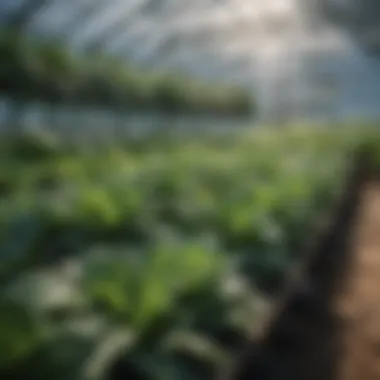
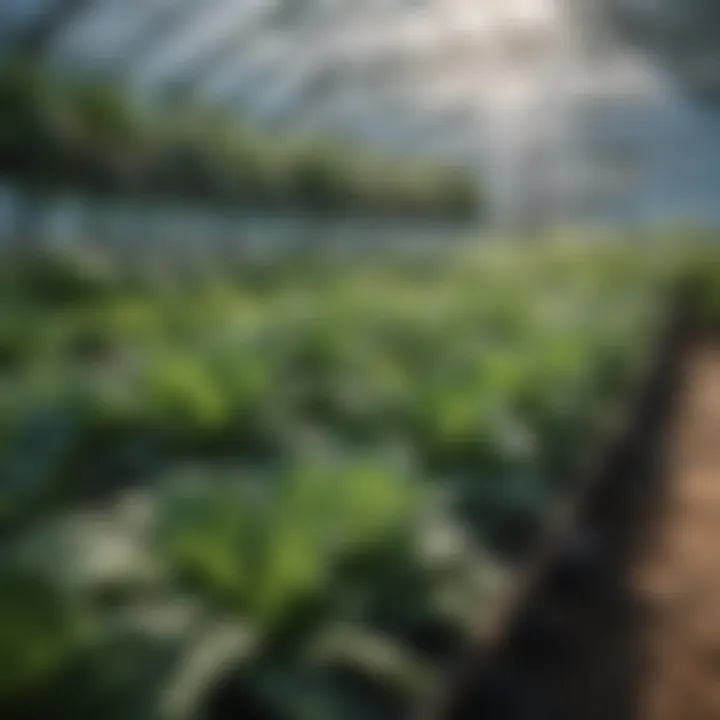
Intro
Growing vegetables in a greenhouse is both an art and a science. This method offers enthusiasts several advantages, such as an extended growing season, reduced pests, and a controlled environment for plants. For homeowners and gardening aficionados, the appeal lies in its potential for higher yields and improved produce quality.
Home gardening has gained traction among many, reflecting an increased interest in sustainability and self-sufficiency. Understanding how to utilize a greenhouse effectively can empower gardeners to maximize their efforts.
The following sections will elucidate essential considerations for greenhouse setup, suitable vegetable varieties for cultivation, and effective maintenance practices. This narrative is structured to provide a comprehensive overview, serving both novice and experienced gardeners alike.
Advantages of Greenhouse Cultivation
Greenhouse cultivation offers numerous benefits:
- Controlled Environment: Temperature and humidity can be maintained, promoting optimal growth conditions.
- Pest Management: Greenhouses protect plants from most outdoor pests, reducing the need for harsh chemicals.
- Extended Season: With a greenhouse, vegetables can be grown year-round, breaking the limitations of seasonal gardening.
- Diverse Variety: Certain plants that may struggle in the local climate can thrive in a greenhouse.
Key Considerations for Setup
Before diving into planting, several factors must be addressed:
- Location: The greenhouse should be sited in an area with ample sunlight and access to water.
- Size and Design: Choose a structure size that matches your gardening ambitions and available space. Lean-to, freestanding, and hoop houses are popular types.
- Materials: Frame materials (aluminum, wood, or galvanized steel) and glazing options (glass, polycarbonate, or polyethylene) should align with budget and durability expectations.
Ventilation and Temperature Control
Proper airflow is critical. Ventilation systems can include roof vents, side vents, and exhaust fans. Consider:
- Natural Ventilation: Strategic placement of vents can utilize prevailing winds.
- Mechanical Systems: Fans and heaters ensure plant health in extreme weather conditions.
Suitable Vegetable Varieties
Certain vegetables thrive better in a controlled environment. Consider growing:
- Tomatoes: They flourish in warm conditions and can produce continuously.
- Lettuce: Fast-growing, perfect for successive small harvests.
- Peppers: They enjoy consistent warmth and benefit from greenhouse conditions.
Effective Maintenance and Care
Regular maintenance ensures a thriving garden. Follow these tips:
- Watering: Regular monitoring and consistent watering schedules help maintain soil moisture. Consider drip irrigation for efficiency.
- Pruning: Cultivating healthy airflow around plants reduces disease risk and improves yield.
- Pests and Diseases: Routine inspections will help detect issues early. Biological controls or organic solutions can minimize intervention needs.
The End
Navigating the nuances of greenhouse vegetable gardening is critical for optimizing yield and quality. By understanding the advantages, strategic setup possibilities, and care practices, enthusiasts can enhance their gardening experiences. This guide aims to equip both novice and seasoned gardeners with the knowledge needed to thrive in the greenhouse environment.
Understanding the Greenhouse Concept
In this section, we will explore the essence of greenhouses, which is fundamental for anyone embarking on vegetable gardening in a controlled environment. Understanding the various components and benefits of greenhouses can significantly enhance the gardening experience and improve yield. A greenhouse acts as a sanctuary for plants, shielding them from outdoor elements while providing a controlled setting for optimal growth. Factors such as temperature, humidity, and ventilation can be modified easily to suit the plants' needs, thus encouraging healthy development.
Defining a Greenhouse
A greenhouse is essentially a structure made predominantly of glass or plastic, designed to cultivate plants in a controlled environmental setting. The primary function of this structure is to harness solar energy, allowing the internal temperature to stay above that of the outside environment. This enables the cultivation of various plants year-round, without the hindrances posed by weather fluctuations. A greenhouse does not merely shelter plants; it creates a microclimate that can promote faster growth and potentially lead to higher quality produce.
Types of Greenhouses
There are several types of greenhouses, each catering to different gardening needs and preferences. Selection of the right type is crucial for optimizing the conditions under which you will grow your vegetables.
Lean-to Greenhouses
Lean-to greenhouses are structures that attach to the side of an existing building. This type is particularly space-efficient and can be an excellent option for homeowners with limited garden space. The proximity to the main building allows for easier access to utilities such as water and electricity. However, they face some limitations in terms of sunlight access, especially if the building casts shade during certain parts of the day.
Freestanding Greenhouses
Freestanding greenhouses stand independently and usually offer more flexibility in design and location. These structures provide ample sunlight exposure from all sides, which can be a significant advantage in growing conditions. Moreover, freestanding greenhouses have the potential for expansion, allowing gardeners to increase their growing area as needed. However, they often require a larger initial investment compared to other types.
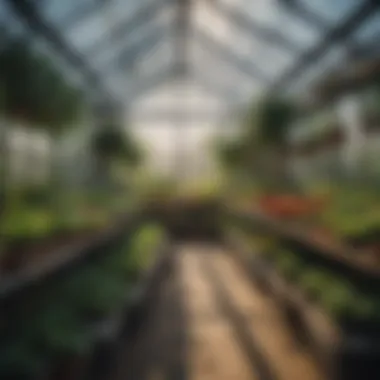
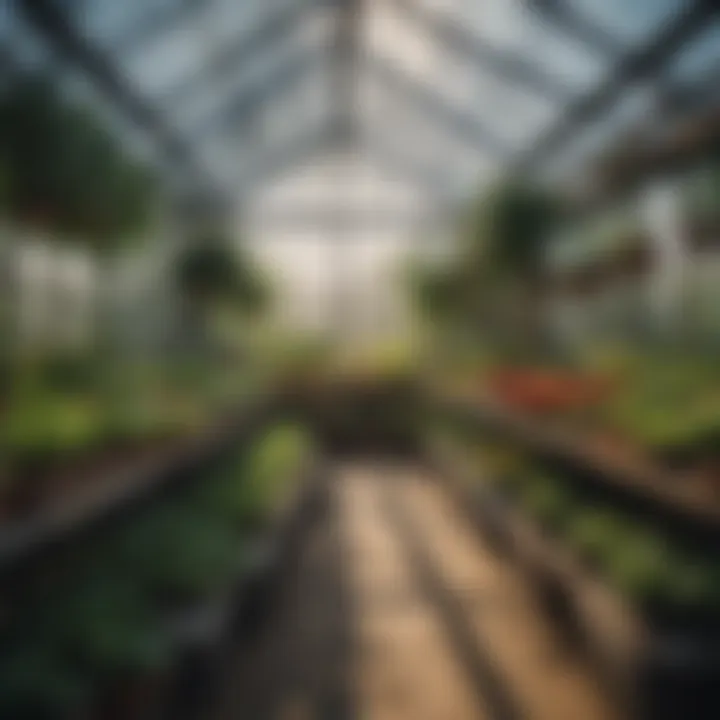
Hoop Houses
Hoop houses are an economical and straightforward greenhouse type, essentially made of PVC or metal hoops covered with plastic. They are lightweight and can be assembled relatively quickly. Hoop houses offer sufficient protection against pests and environmental conditions but may not have the durability of glass or more permanent structures. Their primary advantage is their cost-effectiveness and versatility, making them a popular choice among small-scale growers.
Environmental Control in Greenhouses
One of the defining characteristics of greenhouse vegetable gardening is the ability to control the environment in which plants grow. Three key aspects are temperature management, humidity control, and ventilation strategies. Each aspect is vital for ensuring a successful growing season.
Temperature Management
Temperature management is essential in a greenhouse setting, as it directly affects plant growth and health. A stable, warm environment promotes germination and growing, particularly in early spring or late fall when outdoor temperatures can be too low. Effective temperature control can be achieved through passive methods such as ventilation or active heating systems. One must be careful about overheating, as excessive heat can harm plants, necessitating effective cooling strategies.
Humidity Control
Humidity levels in a greenhouse can significantly impact plant health. Maintaining optimal humidity not only prevents diseases such as mold and mildew but also enhances nutrient uptake by plants. Humidity control methods can include dehumidifiers, proper watering techniques, and ensuring adequate air circulation to hinder excess moisture from settling on plants. Balancing humidity helps to maximize overall plant vigor and yield.
Ventilation Strategies
Proper ventilation is crucial for a greenhouse's functioning, as it ensures fresh air enters and stale air exits. Good ventilation helps in regulating temperature and humidity levels while preventing the buildup of harmful pathogens. Techniques may include using roof vents, louvered side vents, and exhaust fans. Effective ventilation strategies ultimately contribute to a healthier growing environment and better crop production.
Benefits of Growing Vegetables in a Greenhouse
Using a greenhouse for growing vegetables presents numerous advantages that can enhance both the yield and quality of produce. The controlled environment of a greenhouse allows gardeners to optimize various factors that influence plant growth. This section will delve into the key benefits such as an extended growing season, effective pest and disease management, and the ability to control growing conditions consistently.
Extended Growing Season
One of the most significant benefits of greenhouse gardening is the extension of the growing season. In many regions, weather conditions can limit the time available for planting and harvesting vegetables. With a greenhouse, gardeners can start seedlings earlier in the spring and continue growing well into the fall or even winter, depending on insulation and heating methods used.
Regular exposure to sunlight enables plants to photosynthesize efficiently, which promotes faster growth. This is especially important for varieties such as tomatoes and peppers, which thrive in warmer temperatures.
The greenhouse traps heat and retains humidity, mitigating risks from unexpected frosts that could devastate outdoor crops.
Pest and Disease Management
The enclosed structure of a greenhouse offers a barrier against many pests and diseases that commonly affect outdoor gardens. In a greenhouse setting, the likelihood of pests like aphids and caterpillars infiltrating the plants can be minimized through strategic design and maintenance practices. Using screens and other physical barriers can significantly reduce the entry points for these harmful insects.
Additionally, maintaining good hygiene practices in the greenhouse can further lower the risk of disease. Regularly cleaning tools, pots, and the growing area helps prevent the spread of pathogens. Gardeners can also implement integrated pest management (IPM) strategies, utilizing beneficial insects such as ladybugs to combat pests naturally.
Controlled Growing Conditions
Greenhouses provide an environment where critical factors such as temperature, humidity, and light can be strictly managed. This level of control is essential for cultivating high-quality vegetables. For example, specific vegetables may have precise temperature requirements to germinate and grow effectively.
By using thermostats, heaters, and ventilation systems, gardeners can ensure that their plants are receiving optimal conditions year-round. Humidity levels, too, can be monitored and adjusted easily to prevent mold or mildew growth.
Overall, the advantages of growing vegetables in a greenhouse create a conducive environment that not only boosts productivity but also enhances the quality of the produce. The ability to manipulate various aspects of the growing conditions allows gardeners to experiment with a wider variety of vegetables, expanding their gardening options.
Planning Your Greenhouse Vegetables
Planning your greenhouse vegetables is a critical step in maximizing both yield and the quality of your produce. Proper planning allows for optimized growth conditions, increased efficiency in space usage, and a structured approach to gardening. With a clear plan in place, gardeners can better address the unique requirements of different vegetables and ensure that their greenhouse functions optimally throughout the growing season.
Site Selection
Choosing the right site for your greenhouse is fundamental. The location should receive ample sunlight, ideally around 6 to 8 hours daily. It's also crucial to consider water accessibility and drainage to avoid waterlogging, which can be detrimental to plant health. Elevation is another factor—avoiding low spots where cold air settles can help maintain warmer conditions for your crops.
Layout Design
A well-designed layout facilitates easier management of your garden. It determines how efficiently you can move between plants and access all areas for maintenance and harvesting. Two main aspects to consider in layout design are row orientation and spacing considerations.
Row Orientation
Row orientation impacts sunlight exposure and airflow around your plants. Orienting rows north-south generally yields better results, as plants receive even sunlight across their surfaces. This is especially beneficial for taller plants, as they won’t overshadow their neighbors. Moreover, a north-south alignment can improve ventilation, which aids in reducing humidity and controlling temperature. However, in cooler climates, one might consider an east-west orientation to maximize morning sunlight and warmth.
Spacing Considerations
Spacing considerations are essential when planning how close to plant your vegetables. Correct spacing allows for adequate air circulation, which reduces the risk of fungal diseases and promotes healthy growth. Each vegetable species has specific spacing needs, influenced by growth habits and mature sizes. For instance, tomatoes require more space between plants compared to lettuce. Too small a spacing can lead to competition for nutrients and increased vulnerability to pests, while too large a spacing can waste valuable greenhouse space.
Soil Preparation
Preparing the soil correctly is pivotal. Testing soil composition will help understand the nutrient levels, pH, and texture. Ideally, a mix of loamy soil works well in greenhouses, as it retains moisture yet provides good drainage. Adding organic matter or compost enriches the soil, contributing to robust plant health. Ensuring soil is well-aerated will enable roots to grow efficiently and absorb water and nutrients effectively.
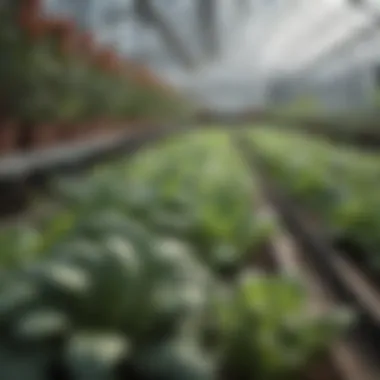
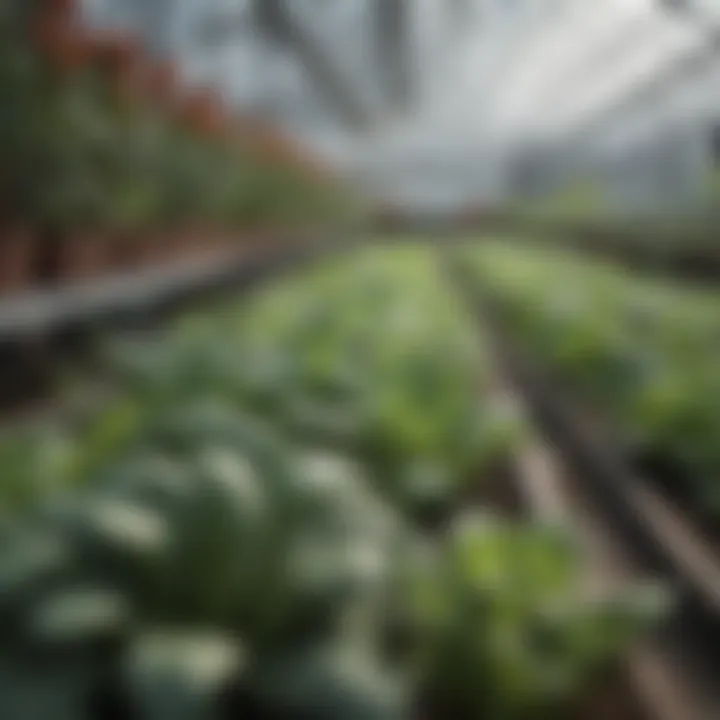
Proper planning and preparation can lead to a more productive greenhouse, thus maximizing the benefits of this investment.
In summary, every aspect of planning—from site selection to layout design and soil preparation—plays a significant role in achieving successful greenhouse vegetable gardening.
Selecting the Right Vegetables
Selecting the right vegetables is critical in optimizing the benefits of growing in a greenhouse. The choice of vegetables impacts yield, flavor, and overall productivity. Different vegetables thrive in varying conditions; thus, alignment with the greenhouse environment is essential. Careful selection can lead to a successful harvest, while poor choices may result in frustration and disappointment.
Best Vegetables for Greenhouse Cultivation
Tomatoes
Tomatoes are one of the most popular choices among greenhouse gardeners due to their versatility. They require warm temperatures and ample sunlight, making them ideal candidates for controlled environments. A key characteristic of tomatoes is their high yielding nature; a single plant can produce dozens of fruits. Additionally, greenhouse-grown tomatoes can be flavorful, as they often ripen more evenly and quickly. However, tomatoes do have specific requirements regarding humidity and support. If not managed properly, they can be prone to diseases like blight, but with adequate care, their rewards significantly outweigh the challenges.
Cucumbers
Cucumbers are another fantastic vegetable to grow in a greenhouse. They thrive in warm environments and can be trained to grow vertically, saving precious space. This is an important aspect, especially in smaller greenhouse setups. Their quick growth rate also makes them a rewarding choice, often producing fruit within a few weeks after planting. However, cucumbers are sensitive to temperature fluctuations. They require consistent conditions, and keeping them well-watered is essential to avoid bitter flavors. With the right care, cucumbers can be plentiful and refreshing additions to any garden.
Lettuce
Lettuce, a staple greenery in many households, grows particularly well in greenhouses. It prefers cooler temperatures compared to other vegetables, making the greenhouse an ideal setting for staggered plantings throughout the year. A significant benefit of lettuce is its quick harvest cycle; many varieties can be ready to eat in just a few weeks. Another appealing aspect is its ability to thrive in smaller spaces, making it suitable for compact setups. However, lettuce is susceptible to pests, and maintaining proper air circulation in the greenhouse is crucial for preventing issues. With careful management, lettuce can provide consistent yields and continues to be a favorite among home gardeners.
Seasonal Considerations
Seasonal considerations are essential when selecting which vegetables to plant in a greenhouse. Different vegetables have specific growing seasons, influencing their potential for yield. Some may thrive best in spring, while others may prefer the warmth of summer or the coolness of winter. Understanding these seasonal nuances allows gardeners to plan for crop rotation effectively. Additionally, combining different plants can help in utilizing the greenhouse space optimally. For example, pairing fast-growing crops like lettuce with slower ones like tomatoes can maximize the growing opportunity. This strategic planting approach contributes significantly to overall productivity.
Maintaining Your Greenhouse Garden
Maintaining a greenhouse garden is vital for achieving optimal yields and ensuring the health of your plants. Regular care includes monitoring watering, managing nutrients, and health checks for your plants. Each of these elements is interconnected, and proper maintenance not only supports your plants but also enhances the overall productivity of your greenhouse.
Efficient maintenance practices foster healthier plants that can withstand pests and diseases. This section will address crucial aspects on how to maintain your greenhouse effectively.
Watering Practices
Drip Irrigation Techniques
Drip irrigation is an effective method for watering plants. It delivers water directly to the plant roots, allowing for precise control over water use. This method is beneficial as it minimizes waste and helps maintain consistent soil moisture. Many gardeners opt for drip irrigation because it reduces the risk of overwatering, which can lead to root rot.
A key characteristic of drip irrigation is its efficiency. It conserves water and requires less frequent application compared to traditional watering methods. One unique feature is the ability to automate the system, enabling integrate with timers that ensure scheduled watering. The main advantage of this technique lies in its efficiency and reliability in promoting healthy plant growth. However, initial setup and cost can be drawbacks to consider.
Watering Frequency
Watering frequency is a critical factor in greenhouse gardening. Plants need water at regular intervals; too little water can stress them, and too much can drown them. The goal is to keep the soil consistently moist. The key characteristic of this topic is its crucial role in plant health.
It is typically recommended to check soil moisture at least once a week. It is helpful to observe weather conditions, as heat can increase evaporation rates. An advantage of having a defined schedule is that it can prevent guesswork and aid in establishing a routine care plan. However, opting for a strict schedule without considering plant needs may lead to problems.
Nutrient Management
Fertilizer Types
Fertilizer types greatly influence plant health and productivity. Options range from organic fertilizers such as compost and manure to synthetic varieties containing specific nutrients. The key characteristic of fertilizer types is their nutrient content. Fertilizers can be chosen based on the specific needs of plants grown in the greenhouse.
Organic fertilizers are popular due to their natural composition and long-term soil improvement. They also contribute to a healthier environment. In contrast, synthetic fertilizers offer quick nutrients, which can benefit fast-growing plants. One of the advantages of organic options is their minimal chemical impact, but they may require more effort in application.
Frequency of Application
The frequency of fertilizer application relates to plant growth phases. Young plants may need different nutrients and more regular feeding than mature ones. This guideline helps in achieving a balanced nutrient supply. The key characteristic is that each plant has specific nutrient requirements at various stages.
Typically, liquid fertilizers are applied every two to four weeks during active growth phases. This approach allows for quick nutrient absorption. A potential disadvantage could be nutrient burn if applied too frequently. Therefore, a careful application strategy is essential.
Monitoring Plant Health
Identifying Pests


Identifying pests is crucial for early intervention. Pests can quickly damage plants if not managed promptly. Observing plant leaves and stems regularly for unusual marks or decay is essential. The key characteristic of this process is vigilance; noticing small changes can avert larger issues.
Common pests include aphids and spider mites, which thrive in greenhouse environments. Regular checks allow for quick action such as introducing beneficial insects or applying organic pest control methods. One benefit of promptly identifying pests is the prevention of widespread damage. However, it can be time-consuming to monitor every plant consistently.
Disease Prevention Strategies
Disease prevention strategies emphasize the importance of keeping the greenhouse clean and organized. Diseases can spread rapidly, and being proactive is critical. A key characteristic of these strategies includes regular cleaning of tools and removing dead plant material.
Implementing proper air circulation and avoiding overcrowding also helps in disease prevention. Monitoring humidity levels is vital since too much moisture can lead to fungal infections. The advantage of these strategies is the increased longevity and productivity of the garden. However, it may require commitment and discipline from the gardener.
Effective maintenance practices are essential for a flourishing greenhouse garden. Regular monitoring, proper watering, nutrient management, and health checks will support the growth and quality of your vegetables.
Harvesting Your Vegetables
Harvesting is a crucial phase in the process of growing vegetables in a greenhouse. Proper harvesting techniques not only influence the quantity of produce but also the quality and longevity of the vegetables post-harvest. Timing plays a significant role here. Every vegetable has a specific window for when it is ripe for picking.
Understanding these nuances enhances the gardening experience. It allows for better yields and ensures that the investment in the garden—time, resources, and labor—does not go to waste. Harvesting at the right moment can make the difference between a peak flavor vegetable and one that is tough or overly mature. Failing to harvest on time can also increase susceptibility to pests and diseases.
This section will delve into the specifics of timing your harvest and the techniques that can be applied to ensure an effective and efficient harvest of your greenhouse vegetables.
Timing Your Harvest
Timing is a delicate balance. Each type of vegetable has an optimal harvest time. For instance, tomatoes should be harvested when they are fully colored; cucumbers need to be picked before they become overripe to maintain their crispness.
Here are some considerations for timing your harvest:
- Knowledge of Mature Size: Regularly inspect plants to understand their growth stages. Familiarize yourself with the expected size and color of each vegetable type.
- Taste Tests: For some vegetables, like zucchini and carrots, a quick taste can determine optimum ripeness.
- Weather Factors: Expect fluctuations in temperature and humidity. When conditions are ideal, it might accelerate the ripening process.
- Seasonal Variability: The time of year can affect maturity. For example, certain crops may ripen quicker in warmer temperatures.
Being attentive to these elements will support productive harvesting outcomes.
Techniques for Harvesting
Once the timing is set, the next step is to employ effective harvesting techniques. Employ the right methods not only makes the process easier but minimizes damage to plants. Here are some techniques to consider:
- Use Clean Tools: Always utilize sterilized garden scissors or pruners. This reduces the risk of transmitting diseases to plants and ensures clean cuts.
- Gentle Handling: Handle each vegetable with care to avoid bruising. This is particularly crucial for delicate produce like tomatoes and peppers.
- Proper Cutting Angle: Cut at a 45-degree angle. This method helps when using the knife, as it allows water to run off rather than pool, which could lead to rot.
- Support the Plant: If using larger containers, support the plant while harvesting. This helps prevent uprooting or damaging the plant structure.
By adhering to these techniques, the quality of the harvested produce can be significantly improved.
Remember, the aim is to enjoy backyard gardening while maximizing both the condition and amount of the vegetables harvested.
Post-Harvest Practices
Post-harvest practices are vital to maintaining the quality and longevity of vegetables harvested from a greenhouse. The way vegetables are handled after cutting affects not only their shelf life but also their taste and nutritional value. This section highlights essential elements such as storage methods and preparing for the next growing season, laying the foundation for successful vegetable gardening.
Storage Methods
Short-term Storage
Short-term storage refers to methods that keep vegetables fresh for a limited time after harvest. This can be crucial for individuals who are looking to enjoy or use their harvests soon after picking. The primary characteristic of short-term storage is that it keeps vegetables in optimal condition for a few days to a couple of weeks, depending on the type of vegetable.
Key benefits of short-term storage include retaining the freshness and flavor of the vegetables. Some popular short-term storage methods include:
- Refrigeration: Keeping vegetables in the refrigerator slows down ripening and prevents spoilage.
- Cool, Dark Places: Storing root vegetables like carrots or beets in a dark, cool area can maintain their texture and taste.
One unique feature of short-term storage is that it is often straightforward and requires minimal resources. However, it has the disadvantage of being time-limited; once the storage period exceeds the recommended time, the quality quickly diminishes.
Long-term Solutions
Long-term solutions aim to preserve vegetables for extended durations, extending the enjoyment of the harvest throughout the year. Processes such as freezing, canning, or dehydrating offer effective ways to achieve this. The key characteristic of long-term solutions is their ability to halt spoilage, allowing vegetables to be stored for months or even years.
Advantages of long-term storage include:
- Reduced Waste: By saving excess produce, gardeners can enjoy their labor without the fear of food spoilage.
- Nutritional Preservation: Proper freezing or canning can maintain much of the vegetable's nutritional value.
However, this method requires more preparation and facilities, which may be considered a disadvantage for some. The unique feature of these methods is that, while they demand effort, they reap rewards later.
Preparing for Next Season
Preparing for the next season is an imperative aspect of maintaining a successful greenhouse. After harvesting, taking time to analyze what worked and what did not can assist in planning for future crops. This involves assessing soil health, replenishing nutrients, and cleaning greenhouse equipment. Well-prepared soil leads to a more robust growing environment in subsequent seasons.







